In 2024, Strong Towns declared Maumee, Ohio to be the nation’s “strongest town,” largely because the city rebuilt its main street to favor pedestrians over cars. It removed two of the four lanes and reduced the amount of parking on the street.
Google Street View of Conant Street before it was rebuilt.
Strong Towns believes that suburbs are not fiscally sustainable. Its goal is to “replace” traditional suburbs with a different kind of development that is supposedly “financially strong and resilient.” This new kind of development includes denser housing, an end to new road construction, and redesigning existing streets to be more walkable and less auto friendly. In other words, New Urbanism.
Google Street View of Conant Street after it was rebuilt.
The residents of Maumee are so thrilled with the street’s reconstruction that they have submitted more than 10,000 signatures to the election board seeking to recall the mayor and six members of the city council. Their real goal is to fire the city administrator, who they believe has run roughshod (with the support of the city council) over citizen interests. Among other things, they are upset that the administrator “was the mastermind that created the stricture reducing Conant Street traffic flow to unbearable levels during peak driving times.”
“Our main uptown area has become a headache to navigate,” reports a resident on Strong Towns’ Facebook page. “The Strong Towns experiment has resulted in traffic cutting through neighborhoods where children play because drivers grow tired of waiting for traffic lights and traffic backs up. In an attempt to promote walking, the city placed a concrete island in the middle of the road. That island has been hit by cars at least four times if not more in the last year resulting in thousands of dollars in damages. The transition to the Strong Towns initiative has also resulted in the closing of some businesses in our uptown region. Our current leaders may think they did a great thing by sending a bunch of our tax dollars to Strong Towns, but talk to most citizens and they will tell you the truth of the negative impact this ponzi scheme has had on a once enjoyable town to live in.”
Although Wikipedia describes Maumee as a “suburb” of Toledo, it isn’t a suburb in the sense that Strong Towns is using the term: post-war bedroom communities for central cities that are the main job centers of their regions. For one thing, Maumee was created a decade or two before Toledo. For another, Maumee has almost 20 percent more jobs than it has residents, while Toledo has less than half as many jobs as residents, so if anything, people are commuting from Toledo to Maumee rather than the other way around.
While Conant Street is an issue in the recall, it isn’t the biggest issue. That is an onerous rental housing ordinance requiring frequent and costly inspections of all rental housing by the city. Jackson, Michigan passed a similar ordinance a few years ago when Maumee’s administrator was working there, and that “ordinance is still being fought in the Michigan courts at great time and expense.”
While the administrator was promoting this ordinance, critics of Maumee’s city government allege, he was neglecting the city’s sewer system, which was in desperate need of upgrading as it was dumping hundreds of thousands of gallons of raw sewage into the Maumee River each year. When the city finally got around to addressing the issue, instead of spreading the costs of the upgrade to everyone, it tried to impose a disproportionate share on people who were selling their homes. All of these things have outraged residents who are ready for a new city council and city administrator.
Strong Towns’ response is that no city is perfect, and “just because Maumee is facing this challenge does not mean that it’s a failure.” At what point does it become a failure? When the city council is recalled and the administrator is fired? When the ordinances that were passed by the council are rejected by the voters?
Strong Towns’ basic premise, that suburbs are more fiscally unsustainable than more traditional cities, is highly questionable. Truth in Accounting‘s 2024 assessment of the financial state of American cities rates suburbs such as Irvine, Plano, Aurora, Riverside, Chula Vista, and Arlington as fiscally healthy while Dallas, Denver, Los Angeles, New York, and San Diego are all basket cases. This is hardly an endorsement of the traditional city design that Strong Towns thinks suburbs should emulate.
The problem with urban planning is that planners don’t understand how cities work, so they plan for the past. Trying to convert suburbs into pre-automobile cities is a classic example. Rather than a model of suburban design, Maumee should be a warning for officials of suburbs elsewhere.



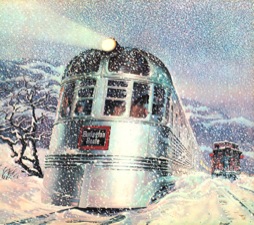

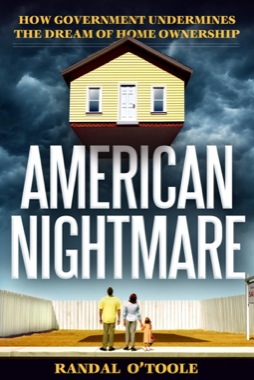
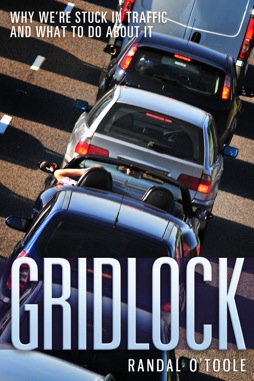
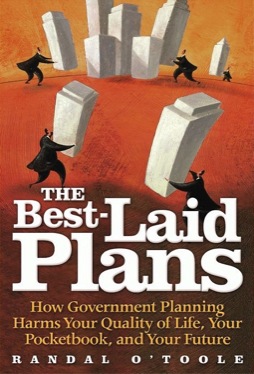
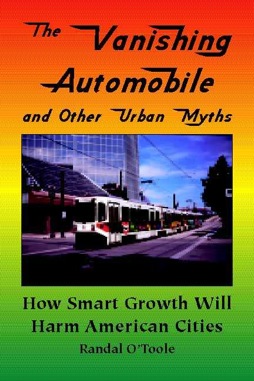
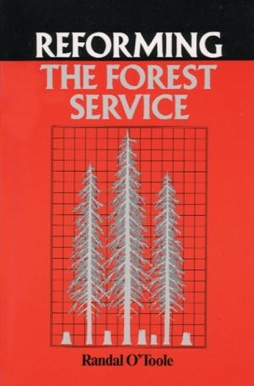
Didn’t get any sense of mayhem promised in the headline. They cleaned up the river and narrowed the main street so cars can’t drive as fast. I guess that counts as mayhem for the AP.
I get a strong sense of mayhem going on right now in city government, considering:
United States Census Bureau
Maumee city, Ohio population estimates, July 1, 2023: 13,633
Following the advice of a group claiming that suburbs were facing a fiscal crisis, Maumee spent tens of millions of dollars on projects that clogged up the city’s transportation and increased housing costs, while it hoped to pay for some of these costs by taxing home sellers. This led thousands of people to sign petitions to recall the city government. It is mayhem or just mismanagement? Either way it alliterates with Maumee.
“We used to have six and half hours of backup on Conant Street in a 24-hour period,” said city administrator Patrick Burtch. “Now we have about two and half hours. And we carry more cars.”
Blatant lie by the city’s administrator.
No one should be surprised that Chuck & Strongtowns – who completely mischaracterized and lied about Remer Minnesota’s sewer issues – do the same with Maumee.
What the city of Maumee isn’t something that has happened to every city. Nor will most city’s have this happen. Chuck brushes Maumee’s sewer issues as nothing more than that.
Chuck says it’s all the growth ponzi scheme so it’ll happen to everyone.
Nothing could be further from the truth.
What happened in Maumee were 2 main things:
a) City leadership for generations failed to put resources into updating the city’s sewer system so they wouldn’t literally dump shit into the river. That’s a lack of investment and is caused by poor leadership, not the magical gremlin Chuck labels “growth ponzi scheme”.
b) Maumee committed fraud and for years reported it wasn’t dumping sewage into the river.
Fraud.
Chuck’s magical “growth ponzi scheme” gremlin not only is a fairy tale but it clearly did NOT cause city employees and leaders to commit fraud.
The gross mischaracterization of Maumee’s sewer troubles as merely complying with EPA regulations is so bad that it amounts to a lie. Maumee has had this issue for generations and fraud was committed.
Like a narcissist would, Chuck later uses a sarcastic “Oh no sewer projects are hard” to try to blow off the mistake Strongtowns made in characterizes a problematically weak town as “strong”.
Maumee’s problems aren’t cuz sewer projects are hard.
Nail in the coffin of ignorance for Strongtowns was to fail to let people know that Maumee’s funding approach was novel. It wasn’t merely that some feather’s were ruffled. No city had ever funded a sewer project like this. Not one. The city had no idea if it would work.
Weird for an org obsessed with invoking how things were done in the past to choose to ignore Maumee doing something that had never been in the past.
Strong Towns Las Vegas here:
Chuck has a point. Modern planned cities whether they are low rise or high rise are expensive.
O’Toole fails to talk about the costly “Stroad” Arterial roads that are 35-50 mph and 4-8 lanes. They fail to function as highway or street. Very costly too.
Much of the gas tax which has been hiked goes to maintain these routes.
At least new areas should have roundabouts which are cheaper than stoplights and need fewer lanes.
https://www.toledoblade.com/local/suburbs/2024/07/20/maumee-sewage-epa-environmental-crime-murky-waters-ruinous-consequences/stories/20240718132
The purpose of a second ordinance passed the same day was less clear. Ordinance 927.35 significantly expanded Maumee property owners’ financial responsibilities for maintaining the sewer system.
Prior to that time, building owners were responsible for sewer pipes running from their homes or businesses up to the curb. The new rule, however, made property owners responsible for the pipes all the way to the sewer main.
The only constant is change.
The US Midwest suburb I grew up in changed over the decades. My earliest memories are of a main street (three lanes in each direction, one used for parking) with small stores (drug stores, beverage stores, shoe stores, restaurants, grocery stores) on both sides of the street along with houses, small apartment buildings and churches. Most houses were on the side streets.
Additional parking was available behind the retail stores.
Then came strip centers with parking in front and in back — not on the street.
Then came shopping malls — two department stores (small versions of their downtown stores) and a selection of clothing, shoe and other small retailers. The mall was surrounded by a very large parking lot and in many ways, it has replaced downtown department stores.
Now we have Big Box stores, often clustered together to create a shopping district near to but not in the city. They are surrounded by vast parking lots as well as restaurants of all kinds. They have become the centers of commerce.
Today we have people who what to go back in time to recreate the small “walkable” town that is better suited to horses and bicycles than to automobiles but is not suited to a population that drives cars or shops at Home Depot and Walmart.
Maybe Amazon will replace local retail and relegate “downtown” to history. And cars will be used for church and Sunday drives in the country.
WrongTowns’ model is for the city buildings or government to be the “master” that the residents and owners of property within its geographic territory are supposed to be giving up money and basic property rights for.
Consider WrongTowns promotion of schemes to tax land at a rate much higher than improvements. The plan is to encourage/force land owners to build up their property (i.e., densify) to stay ahead of taxes regardless of whether such building would be supported by any market.
https://www.strongtowns.org/journal/2020/2/27/anchorage-held-hostage
WrongTowns promotes absurd schemes and control over your property. Its goal is to generate more revenue for a city for “sustainability”. WrongTowns often looks the other way with respect to reining in costs and government spending in its analysis.
Historically, as support for its Mission, the organization’s stated “Principles” includes gems such as
“Land is the base resource from which community prosperity is built and sustained. It must not be squandered.” In other words, they decide what’s best for YOUR land. If you aren’t riding the density train you are squandering your land and that must not be permitted.
https://web.archive.org/web/20180330223336/https://www.strongtowns.org/mission/
Woah!? Where do we force?
We want the ability for a single family home to convert his home to a duplex, fourplex or even add an ADU.
Some homes by the inner cities have become very valuable due to its proximity to jobs and amenities. Growing outward doesn’t fully solve the problem.
– Strong Towns Las Vegas
Apparently I’ve been observing WrongTowns for longer than you have been a cult member. I provided links to WrongTown articles that support my argument. All you did is make arguments denying WrongTowns’ position. Of course you did not cite to any articles on the site.
In one of the articles, WrongTowns cast undeveloped owners as evil scheming land speculators. So the organization promotes forced development by imposition of a land tax totally disregarding any actual market for the development. Your denials are not supported by the years of articles on the cult website.
You need de-programming intervention or at least the ability to review your organization’s published articles before you go into denial stage.
Your analysis of Strong Towns is misleading.
We don’t FORCE dense development. we remove the barriers that limit fourplexes, ADUs, etc..
Areas can be more dense WITHOUT decreasing the share of detached homes including lot sizes.
Our top main goals are:
– Removing parking requirements
– Stop requiring/constructing “stroads” or arterial roads (often 4-8 lanes of 35-50 mph)
– New development shouldn’t just be zoned large scale single use.
– Strong Towns Las Vegas
Not based upon the articles, mission statements, etc. posted over the years. WrongTowns is very much anti-car for sure. Every other article is anti-car making the same old “arguments”. You have no transportation alternative to roads. Believing people will simply walk or bike to grocery, kid’s schools, doctor appointments, is a religion not rational thought.
As far as “zoning” we don’t have that outside of cities, yet all these things you claim zoning is a barrier to are not materializing where the supposed barriers are non-existent.
Why don’t you look at your organization’s website, principles, etc. a bit more closely. Notice the characterization of “strong citizens” (i.e., “people who care”). You are a “strong citizen” if you follow the cult leader mantra. You are a weak citizen and “don’t care” if you don’t adopt the teachings of the cult. You need de-programming if you cannot see what is actually being promoted or want to claim my statements somehow mischaracterize your organization. There are years of repetitious articles, mission statements, etc. put out by your organization (cult) to support my observations – and I’ve cited to just a few from the organization’s own website. You want to deny it but you can’t cite to any organization articles to support your position AND your position is undermined by the overwhelming number of articles to the contrary from the organization.
It should not be the end of the world IF a person cannot drive to their daily necessities especially if the housing is multi-family or lots below 8,000 square feet.
This was the case in areas planned 90+ years ago. Codes and policies changed that.
Pedestrian friendly areas even make car sharing programs more efficient.
I saw the link. Did not see anything flawed.
It’s 2025. People in modern suburbs are within a couple miles of their daily needs. They could bike or walk. They choose to drive.
“We don’t FORCE dense development.” Yes you do. That is standard rhetoric planners and density advocates use to deny exactly what you are trying to do. Its more like “We don’t come out at say we are forcing density but we promote every policy imaginable to force density.”
Strong towns also said cities are run out money.
Cities run out of money, but suburbs are flush with cash… If the economies of scale of density were greater than the costs of density, the tallest buildings in Manhattan should have the cheapest rents and the NY MTA would be flush with cash and not need automobile drivers to fork over 9 dollars a day (3x the subway fare).
That has to do mainly with poor leadership mainly and not the physical cost itself.
Cyrus992 wrote, “We want the ability for a single family home to convert his home to a duplex, fourplex or even add an ADU.”
So … I could sell my house on a quiet suburban street to a developer who would replace it with a four-story apartment or condo fronted by a parking lot?
Sure, but it certainly makes more sense to hide the parking.
Other than the standard urbanest propaganda, they support their position with some rather absurd analyses about how the tax base funds infrastructure. Their main advocate on that issue is Joe Minnecozi. His basic argument is that density results in more taxable property per acre therefore it must be superior to lower density. The problem is that he makes the assumption that a city can only be composed of only high density housing and there is no increase in infrastructure cost with higher density properties. Ultimately, Strong Towns is exploited a biased, anti car, anti low density bent amongst a segment of the population to handsome consulting fees.
We believe in building roadways/highways strategically not “Stroad” arterial routes. That is not anti car.
– Strong Towns Las Vegas
Anyone who uses the term “stroad” rather than arterial is immediately suspect. One of the things I have noticed about density advocates like yourself is that you use made up emotionally laden terms like “sprawl”, “car dependent” “vibrant” “sustainable” to describe things that should be technical in nature because you know it will create a negative con notion in people’s minds.
What terms do you recommend we use?
I use the term: Modern Urban Planning Post 1930s system.
How about terms for what you don’t just promote but want to impose? Let’s label the housing and lifestyle you promote:
• Transit-dependent housing, workplace, school, and commerce?
• High tax burdened housing? Look at all the articles on WrongTowns focusing on Urban3 3-D charts claiming all the revenue that can be extracted by the city from people in hamster-style housing in tall towers.
• Anti-family, anti-disabled, and anti-senior/mobility housing? Multiple flights of stairs to get to your hamster-style housing unit is not particularly suitable for many households.
It’s 2025. People in modern suburbs are within a couple miles of their daily needs. They could bike or walk. They choose to drive.
Chuck has repeatedly claimed that no new highways should be built.
From Strong Towns Winner Winner Chicken Dinner page:
How Maumee leaders engage with the public and listen to them:
For 38 years as a city manager, I have been involved with a plethora of infrastructure and development projects. Unfortunately, many residents do not fully understand why these changes are being undertaken in our community.
CityData:
– Population in 2022: 13,689.
– Population change since 2000: -10.2%.
– Daytime population change due to commuting: +10,163 (+74.1%).
“Anyone who uses the term “stroad” rather than arterial is immediately suspect.”
Also people who talk about per-capita road deaths rather than per-trillions of mile road deaths. More death is not a big deal as long as it’s accompanied by more freedom (quadrillions of miles driven).
If we looked at total deaths rather than how many relative to usage, then playing Russian roulette would be deemed incredibly safe because maybe only one idiot a year dies playing it.